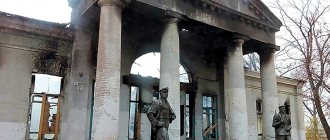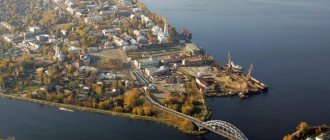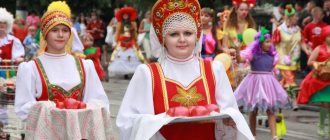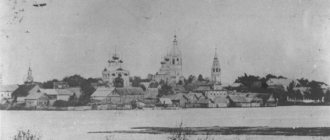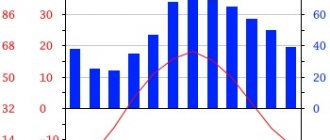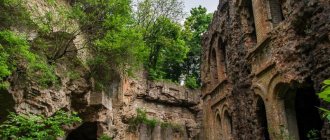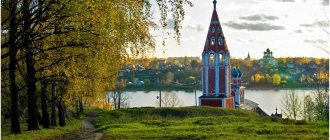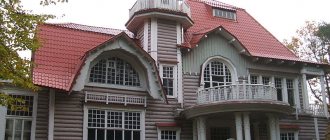Kineshma is a provincial town located on the banks of the Volga just 100 kilometers from Ivanovo.
The second name of the city is “Volga Switzerland”, all because the city is simply buried in green forests and surrounded by expanses of water, a beauty comparable to the Swiss Alps. The name “Kineshma” itself is translated as “safe haven”. The city of Kineshma has its own unique, incomparable atmosphere, which is expressed in everything - in culture, architecture, history of the city and the region. So, despite the small size of the city, you will have a lot of impressions from the trip. Kineshma - a variety of architectural monuments, various museums and exhibitions, squares and boulevards; the popular sanatorium named after Stanko is especially worth noting.
The article contains the TOP 17 attractions that are worth visiting in Kineshma.
Volzhsky Boulevard
This is probably one of the main and most beautiful attractions of the city. The boulevard is located along the banks of the Volga River and has a length of about 800 meters. This is a place where mass celebrations and holidays take place. The boulevard has a large number of places to relax, both beautiful openwork benches and separate gazebos, children's attractions and Soviet-era sculptures. In addition, the first residential buildings made of stone are located on the boulevard, the construction date of which dates back to the end of the seventeenth century.
Where to eat
Of all the establishments in the city, the following stand out:
- Coffee shop on Malaya Pokrovskaya. Located on the street. Lenina, 22.
- Cafe Coffee shop Caramel. Located on the street. Lenina, 55.
- Restaurant Russian Izba. Location – Volzhsky Blvd., 2.
- Pivgrad. Address: st. Gogol, 2/67.
- Peaceful Pier. Located on the river on Volzhsky Boulevard.
- Cafe Pyramid. Located on the street. them. M. Gorky, 25.
- Restaurant Volzhskie Zori. Located on Volzhsky Boulevard.
- Cafe Yamato. Address: st. Maxim Gorky, 19.
According to numerous reviews from visitors to the Venice pizzeria, it is not recommended to dine here, as the prices are inflated and do not correspond to the quality.
Sanatorium named after Stanko
The sanatorium offers a variety of healing and treatment procedures, for example, “beautiful figure”, “healthy child”, “cleansing the body” and so on. The highly qualified staff of the hospital can prepare an individual program for everyone. In summer, the resort has a beach, water attractions, and you can also play tennis. In winter, here you can go tubing, ice fishing, ice skating or skiing, and play laser tag.
Exhibition “Kineshma felt boots”
Here are felt boots of different sizes, listed in the Russian book of records. You can also get acquainted with the step-by-step technology of their manufacture. The entire exhibition occupies 3 rooms; you can order a guided tour.
Kineshmansky felt boots - a landmark known throughout Russia
- Location: st. Frunze 6.
- Opening hours: 10:00-16:00.
- Closed: Monday.
Trinity – Assumption Cathedral
This is a whole church complex in the classicism style of two cathedrals, a bell tower and a priest's house. The complex was built in the second half of the seventeenth century. The entire complex was built with donations from parishioners. The main relic of the cathedral is the icon of the Mother of God, painted during the reign of Mikhail Fedorovich. The height of the bell tower reaches 63 meters, and the height of the spire is 11 meters. The cathedral can be reached on foot in 20 minutes from the train station. Address: Sovetskaya street, house 2. The temple is open to visitors at any time.
Monuments and sculptures
Kineshma, whose attractions are a combination of new buildings and historical monuments, is famous for its many monuments.
House of notary Gorodetsky
The building, made of 1 floor, made of red brick, is an archaeological site with modernist fragments. The northern facade of the building is finished figuratively and turned towards the Volga.
During the period of Soviet power, the mansion housed a children's clinic; now installation work is being carried out here. Location – st. Soviet 36.
Monument to Commander Fyodor Boborykin
The monument was opened on September 22, 2012 and was built by city residents at their own expense in honor of commander Fyodor Boborykin, who led the militia in 1609. He was one of the first to repel the invaders. The authorship belongs to the sculptor Ravil Yusupov. Location – pl. Revolutions.
Temperance society tea room
The building was erected in the 2nd half of the 19th century. This is one of the non-alcoholic cafes that opened at the Holy Cross and Ascension churches. The usual menu is tea with sweets, jam or sandwiches.
The proceeds went to public needs. In 1917, the headquarters of the revolution , the Council of Working People's Deputies, was located in this place, as written on the memorial plaque installed on the left side of the building. After some time, cafes and shopping boutiques were located here. Nowadays there is a hotel complex in the teahouse.
Episodes from the films “The Ulyanov Family” and “Yakov Sverdlov” were filmed against the backdrop of the building.
Location – Volzhsky Blvd. 1a.
Mansion of the manufacturer Mindovsky
The house was built in the 2nd half of the 19th century. by order of Ivan Mindovsky, a major industrialist for his passion. The building went down in history as the “grain commission”. In 1906, unrest arose in the city, and a strike of the working class was organized due to the rise in prices of grain traders due to a bad harvest. On February 15, 1907, a “grain commission” consisting of 18–25 people moved into the house.
They exercised control over sellers, forcing them to sell bread at the set price, without inflating it. After 2 weeks, the commission was dispersed by Cossacks who arrived from Kostroma.
In 1917, the house housed the Council of Workers' and Soldiers' Deputies, and the headquarters of the Red Guard was also located here. Now the building has been transferred to the Regional Tuberculosis Dispensary. Location – st. Soviet 10.
Monument to Alexander Mikhailovich Vasilevsky
The monument was erected on July 31, 1949 in connection with the order of the Supreme Council of the Soviet Union on the erection of busts of double Heroes of the USSR in their places of birth. The author of the sculpture is E.V. Vutetich.
Alexander Vasilevsky was twice awarded the highest military order, and twice he was awarded the title of Hero of the USSR. Location - crossing of the street. Ostrovsky and st. Lenin.
Ostrovsky Drama Theater
Ostrovsky's name is very closely connected with the city of Kineshma. Here he worked and wrote all his most outstanding works, “The Thunderstorm”, “Dowry” and many others. In honor of the famous writer and playwright, the Drama Theater was opened in 1897, which bears his name. It was created with the direct participation of his family members. This is one of the oldest provincial theaters in Russia. The first performance was based on Ostrovsky’s play “Poverty is not a vice.” Its premiere took place on December 26, 1897.
Later, the theater moved to new premises at 12 Sovetskaya Street. Today, the theater lobby is decorated with panels and tapestries depicting scenes and characters from Ostrovsky’s plays. You can learn more about the life and work of Ostrovsky himself at the Ostrovsky Memorial and Literary Museum, which is located in the village of Shchelykovo, 20 kilometers from the city of Kineshma. It was there that his estate was located, and it was there that he spent several months every year.
Art Gallery
Located in an old charity house for the poor with the Church of the Blessed Virgin Mary. The building is an architectural monument of the 19th century. The first floor is the Exhibition Hall, which houses works by contemporary masters: paintings, sculptures, installations. The “Art of the 20th Century” hall displays the works of artists who connected their work with Kineshma.
The gallery features works by many artists:
- I. Aivazovsky;
- K. Korovin;
- K. Savitsky;
- L. Turzhansky;
- V. Bychkov;
- L. Chernov - Plessky;
- M. Malyutin.
Works by I. Aivazovsky “Trebizond. 1884" and K. Korovin's "Sevastopol" were restored with donations from guests. Location: st. Bolshaya Komsomolskaya 30.
Sevryugov Estate
The estate belonged to local manufacturers and was built in 1904 in the Art Nouveau style. A small park was laid out around the estate. During the revolution, the Sevryugin factory itself and their mansion were nationalized, and the owners fled to France. This building later housed a cultural center with various clubs, a music and art school. In the nineties, the cultural center was closed, over time the park turned into a real forest, and the estate itself was destroyed. Today, many legends are associated with this place, including the existence of ghosts in the estate. There is even a photograph of the estate circulating on the Internet, where the silhouette of a girl in a ballgown can be seen.
Cinema "Passage"
The cinema was built at the beginning of the twentieth century. with money from the merchant Tikhomirov and called itself “Modern”. This is a rectangular elongated house, two-level. The main facade of the building, looking at the street. Ryleevskaya, decoratively decorated.
Next to the cash register there is a dressing room, then a hall located on another level. Initially, retail space was located in the lobby, and a restaurant was located on the ground floor. In 1920, the cinema was nationalized and turned into a warehouse.
Most of the interior decorations were also destroyed. Now there is a cultural and entertainment center here. Location: st. Ryleevskaya 4.
Shopping arcades
At the end of the 19th and beginning of the 20th centuries, fairs in cities were of enormous importance and were held regularly. So in Kineshma, Red Trading Rows were built for these events. The style of this building is truly unique; it combines eclecticism, modernism and Romanov classicism.
Today, the shopping arcades have not lost their original purpose and have been preserved almost in their original form. Thanks to the shopping arcades, the central square of Kineshma is original and beautiful in its own way.
Location: Krasny Metalist street - 12.
Church of the Nativity
The church was built in 1754 at the expense of parishioners. Later, at the end of the 19th and beginning of the 20th centuries, the church was restored and rebuilt. It was closed in the 1930s. Until 1993, the church housed the metalworking workshop of the Kineshma plant named after Kalinin.
All the interior decoration was lost, only fragments of 19th-century paintings survived on the eastern wall of the refectory. Since 1993 - transferred to the Russian Orthodox Church. Today it is under restoration, however, services are held in the church regularly.
Location: Yuryevetskaya street - 13.
Where to stay
There are 3 main hotels in the city:
- Sadko Hotel. There is a bar, free WI-Fi, 24-hour reception, and a restaurant. The cost of breakfast is 120 rubles, lunch is 200 rubles, dinner is 150 rubles. The average cost of accommodation for 1 person per day is 1200 rubles. Address: st. Shchorsa 1a.
- Peaceful Pier. The hotel is located in a house on the water, 5 min. Walking distance from the city center. Type of breakfast - continental, buffet. There is private parking and a bar. The average daily cost for 1 adult is 2,700 rubles.
- Volga. The hotel is located on the outskirts of the city. There is a fitness center, restaurant, and free Wi-Fi. Cost per day – 900 rubles.
No less popular is the option of renting an apartment, especially if the trip is planned by a group of people:
- Apartment on the street Red Metalist 31. Total area 60 m2, accommodates up to 6 people. Pets are allowed. Cost per day – 3500 rubles.
- Santa Barbara. Address: st. Kasimikhenskaya 1. Pets are allowed. Price per day – 700 rub.
- Apartment on the street Sports 2 . The total area is 36 m2, the number of guests is 2. There is a kitchen and free Wi-Fi. Cost per day – 1500 rubles.
Kineshma ()
What to see in Kineshma
Let's start getting acquainted with the city from the right bank of Kineshemka, where on Yuryevetskaya Street there is the Alexander Nevsky Church . It was built in 1895 as a cemetery at the expense of the bourgeois society. During Soviet times it was closed and converted into a warehouse. Currently, it has been handed over to believers, restored, and services are held in it.
If you walk along Yuryevetskaya towards the Volga, then on the left there will be a monument of religious architecture - the Church of the Transfiguration . It was built in 1694 and is considered the oldest stone temple in Kineshma. Over its three-hundred-year history, the temple has undergone significant damage, but is currently restored and functioning.
Now we cross Kineshemka along the Nikolsky Bridge and find ourselves on Ivanovskaya Street, which leads to the city center - to Revolution Square. In the center of the square stands a monument to voivode Fyodor Boborykin , who heroically defended the fortress from Polish invaders during the Time of Troubles. It was installed in 2012 at the expense of the townspeople.
On the left there is another reminder of those tragic events - the Chapel of the Exaltation of the Holy Cross . It was installed in 1744 on the site of the mass grave of the defenders of the fortress. Every year on June 8, memorial services for the victims are held here. By the way, this chapel is depicted in the painting “Fair” by Boris Kustodiev.
On the right stands the Church of the Annunciation , a monument of religious architecture from the early 19th century. The snow-white temple was built in a classical style with Baroque elements and initially had a separate bell tower, but was later connected to it by an attached refectory. The church is active and has a library and a pilgrimage department.
Near the square there is a local history museum . It occupies a former bank building, built in the 19th century and rightfully considered one of the most beautiful in the city. The museum has exhibitions dedicated to the history of the local peasantry and merchants; among other things, there are many ancient household items.
Next door is another historical building - the Passage cinema . It was built in 1908 by local merchant Tikhomirov and even then combined a restaurant, retail outlets and a hall for film shows. Currently, the building still operates as a cinema.
Next to the cinema is the Tikhomirov House , one of the most remarkable buildings in Kineshma. It was built in the mid-19th century by merchants and philanthropists the Polenovs and for a long time was the most luxurious residential building in the city.
However, the building was badly damaged by a fire in 1890, after which it was bought by the merchant Tikhomirov and restored, and the lower floor was rented out to trade organizations.
Opposite are red and white shopping arcades . They were built at the expense of local merchants at the turn of the 19th and 20th centuries. The red shopping arcades are especially noteworthy. They are built of red brick and decorated with octagonal domes and patterns laid out of brickwork. The buildings are used for their intended purpose: they house retail outlets.
Nearby, on the steep bank of the Volga, you can see one of the symbols of the city - the temple complex of the Assumption and Trinity Cathedrals . The Assumption Cathedral was built in 1745, the Trinity Cathedral a century later.
The temple complex also includes an elegant 76-meter bell tower topped with a spire with a cross, a fence with a gate and a stone gatehouse. Since 1960, the complex has been protected by the state as a monument of federal significance.
Under the walls of the Assumption Cathedral there is another interesting place - the Russian Izba restaurant-museum . It is stylized as a traditional peasant hut, and the main decorative elements are household items collected from the villages of the Kineshma region: samovars, hooks, bast shoes and even a real Russian stove.
Volzhsky Boulevard , begins from the “Russian Hut” . It offers picturesque views of the Volga, and various city events, exhibitions and festivals are held here. The embankment is decorated with three gazebos, as well as ancient houses built in the 19th century.
The modern decoration of the boulevard is the Drama Theater named after. A. N. Ostrovsky. Alexander Nikolaevich often visited the Kineshma land and described local realities in his works, and his Shchelykovo estate was located not far from Kineshma (now the Kostroma region).
The theater has existed since 1897 and since then, according to tradition, it opens each season with a play by A. Ostrovsky.
A very remarkable building on the embankment is the two-story house of the merchant Shemyakin . Built in 1913 in Art Nouveau style, in 1973 it was recognized as a monument of civil architecture. Currently, the house has been restored and houses a wedding palace.
Nearby is the Church of the Ascension , built in 1779. It is designed in Russian classical traditions, has a massive quadrangular base and domes of an unusual elongated shape. Until 2011, a local history museum operated in the temple building; now it is a functioning church.
Next door, on the site of the former Ascension nunnery, stands the Church of St. John Chrysostom . It was built in 1760, after the 1917 revolution it was used as a warehouse and workshops, so it was badly damaged. Ancient paintings on the walls of the temple have been partially preserved, but the church is in need of restoration.
If you walk along Sovetskaya from here and turn onto Frunze, you can visit the felt boots museum . It was opened in 2012 by the Sokolov family of artisans. The exhibition features felted shoes decorated with beads, rhinestones, lace, as well as the smallest (less than 10 mm) and largest (more than 2 m) felt boots, included in the Russian book of records.
Nearby there is an art and historical museum , the basis of the exhibition of which is made up of objects from the private collection of N.P. Ruzsky. Here you can see paintings by Russian and European artists, sculptures, porcelain, as well as furniture from the late 19th - early 20th centuries.
A favorite vacation spot for citizens and guests of the city is the park named after. 35th anniversary of the Victory . At the entrance there is a museum of military equipment, in the park itself there are attractions for children and adults, there is access to the city beach, and in the warm season thematic events and discos are held here.
Another interesting place is the museum of Bishop Vasily of Kineshma. Saint Basil was a hereditary priest who lived a complex but amazing life, which you can learn about in the museum.
The bishop's personal belongings and household items are presented here; most of the exhibits were carefully kept in the families of the descendants of his parishioners for many decades.
On the outskirts there is another place worthy of attention - the Sevryugov estate . Or rather, what's left of it. It was built at the beginning of the 20th century on the banks of the Volga, and a massive marble staircase led to the river from the estate.
The house was surrounded by a landscaped garden. In Soviet times, a club and an art school were located here; now the estate is abandoned and needs restoration.
